Evaluating Glamour Stock Performance vs. Value Stock in Russia
VerifiedAdded on 2023/04/21
|32
|9166
|315
Report
AI Summary
This report evaluates the performance of glamour stocks versus value stocks in the Russian market. The study aims to build a model to predict the future growth of both glamour and value stocks, addressing the uncertainty in forecasting their potential. The research employs a quantitative approach, utilizing secondary data from the Bloomberg website, with dependent variables including the growth rate of glamour and value companies, and independent variables such as return on stocks, price-to-book ratio, price-to-earnings ratio, equity price, and book-to-market ratio. The methodology involves descriptive and correlational study designs, including summary statistics, graphical analysis, correlation analysis, ANOVA, and regression analysis. The report examines the background of the Russian stock market, the Moscow Exchange, and existing literature on glamour and value stocks, including their comparison, the impact of book-to-market ratios, arbitrage risk, and investor sophistication. The study formulates hypotheses regarding the association and difference in growth rates, and the predictability of future growth using financial ratios, with findings expected to benefit business analysts, stock brokers, individual companies, investors, government, academicians, and economists.
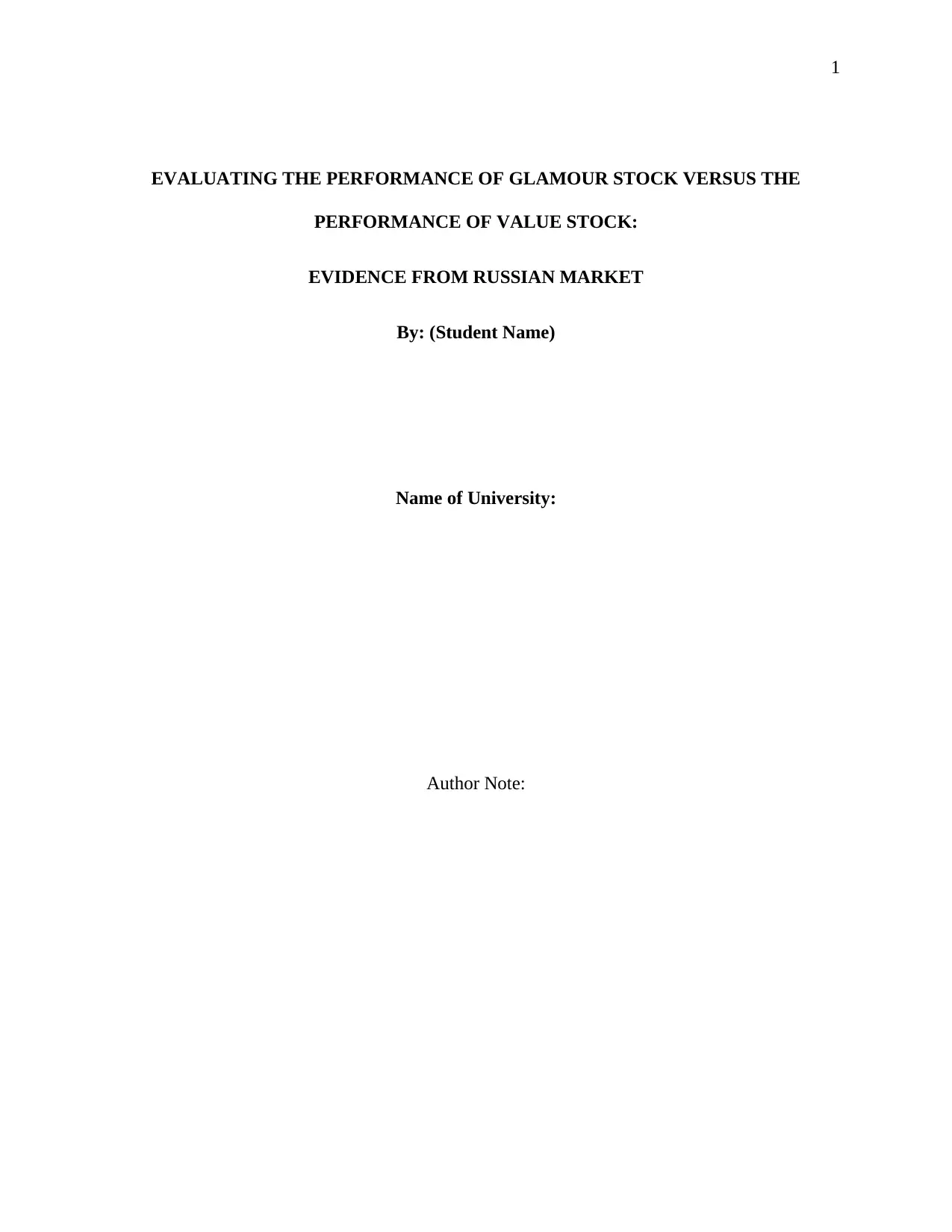
1
EVALUATING THE PERFORMANCE OF GLAMOUR STOCK VERSUS THE
PERFORMANCE OF VALUE STOCK:
EVIDENCE FROM RUSSIAN MARKET
By: (Student Name)
Name of University:
Author Note:
EVALUATING THE PERFORMANCE OF GLAMOUR STOCK VERSUS THE
PERFORMANCE OF VALUE STOCK:
EVIDENCE FROM RUSSIAN MARKET
By: (Student Name)
Name of University:
Author Note:
Paraphrase This Document
Need a fresh take? Get an instant paraphrase of this document with our AI Paraphraser
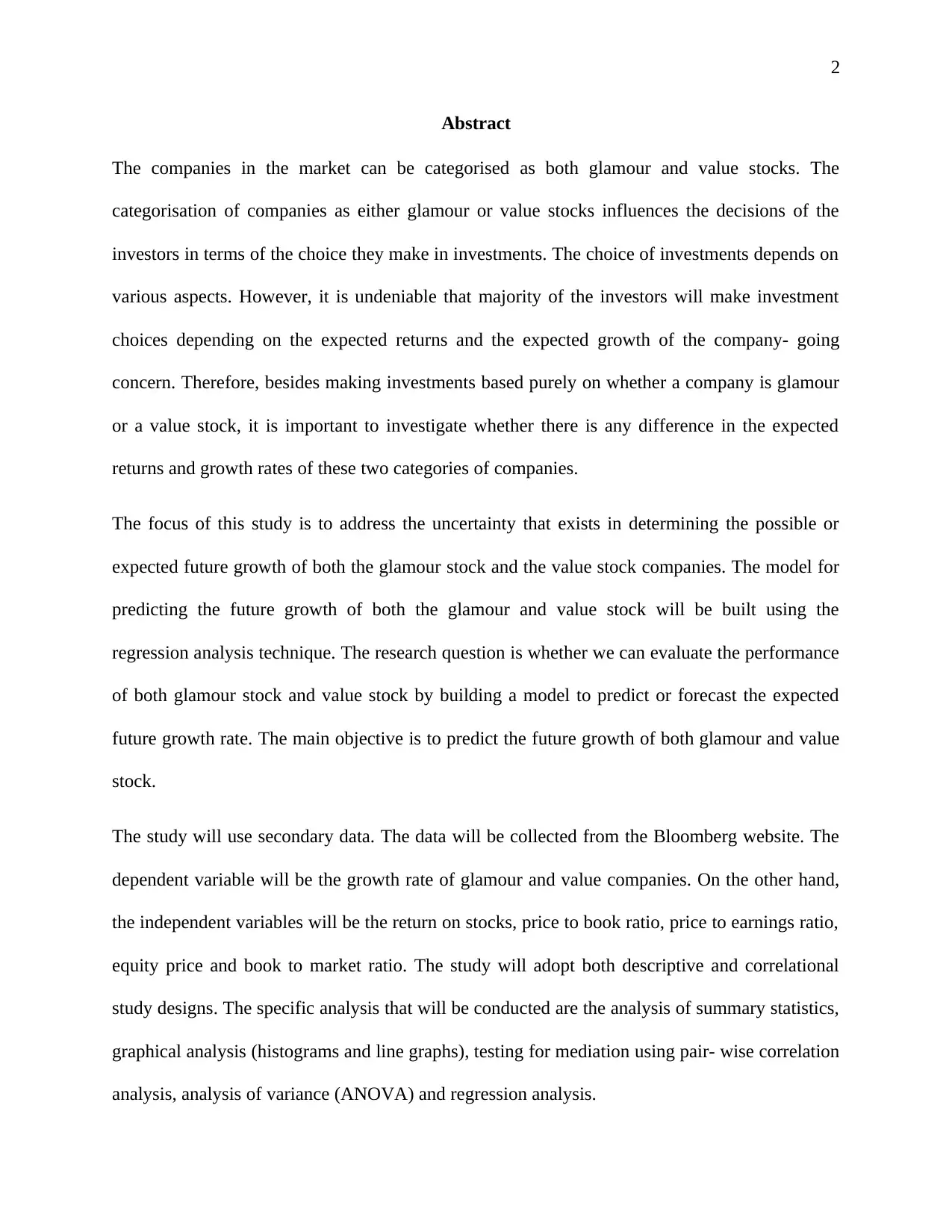
2
Abstract
The companies in the market can be categorised as both glamour and value stocks. The
categorisation of companies as either glamour or value stocks influences the decisions of the
investors in terms of the choice they make in investments. The choice of investments depends on
various aspects. However, it is undeniable that majority of the investors will make investment
choices depending on the expected returns and the expected growth of the company- going
concern. Therefore, besides making investments based purely on whether a company is glamour
or a value stock, it is important to investigate whether there is any difference in the expected
returns and growth rates of these two categories of companies.
The focus of this study is to address the uncertainty that exists in determining the possible or
expected future growth of both the glamour stock and the value stock companies. The model for
predicting the future growth of both the glamour and value stock will be built using the
regression analysis technique. The research question is whether we can evaluate the performance
of both glamour stock and value stock by building a model to predict or forecast the expected
future growth rate. The main objective is to predict the future growth of both glamour and value
stock.
The study will use secondary data. The data will be collected from the Bloomberg website. The
dependent variable will be the growth rate of glamour and value companies. On the other hand,
the independent variables will be the return on stocks, price to book ratio, price to earnings ratio,
equity price and book to market ratio. The study will adopt both descriptive and correlational
study designs. The specific analysis that will be conducted are the analysis of summary statistics,
graphical analysis (histograms and line graphs), testing for mediation using pair- wise correlation
analysis, analysis of variance (ANOVA) and regression analysis.
Abstract
The companies in the market can be categorised as both glamour and value stocks. The
categorisation of companies as either glamour or value stocks influences the decisions of the
investors in terms of the choice they make in investments. The choice of investments depends on
various aspects. However, it is undeniable that majority of the investors will make investment
choices depending on the expected returns and the expected growth of the company- going
concern. Therefore, besides making investments based purely on whether a company is glamour
or a value stock, it is important to investigate whether there is any difference in the expected
returns and growth rates of these two categories of companies.
The focus of this study is to address the uncertainty that exists in determining the possible or
expected future growth of both the glamour stock and the value stock companies. The model for
predicting the future growth of both the glamour and value stock will be built using the
regression analysis technique. The research question is whether we can evaluate the performance
of both glamour stock and value stock by building a model to predict or forecast the expected
future growth rate. The main objective is to predict the future growth of both glamour and value
stock.
The study will use secondary data. The data will be collected from the Bloomberg website. The
dependent variable will be the growth rate of glamour and value companies. On the other hand,
the independent variables will be the return on stocks, price to book ratio, price to earnings ratio,
equity price and book to market ratio. The study will adopt both descriptive and correlational
study designs. The specific analysis that will be conducted are the analysis of summary statistics,
graphical analysis (histograms and line graphs), testing for mediation using pair- wise correlation
analysis, analysis of variance (ANOVA) and regression analysis.
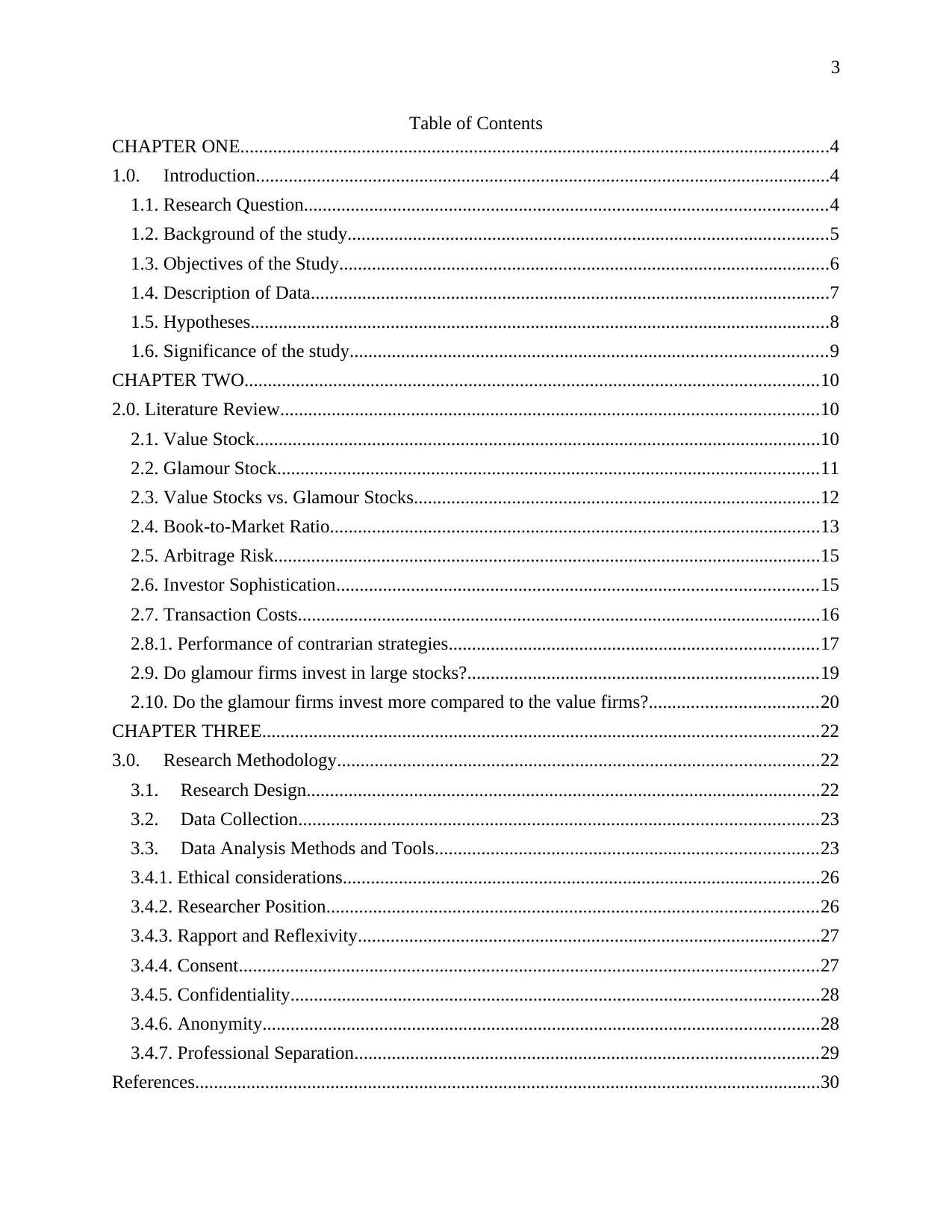
3
Table of Contents
CHAPTER ONE..............................................................................................................................4
1.0. Introduction...........................................................................................................................4
1.1. Research Question................................................................................................................4
1.2. Background of the study.......................................................................................................5
1.3. Objectives of the Study.........................................................................................................6
1.4. Description of Data...............................................................................................................7
1.5. Hypotheses............................................................................................................................8
1.6. Significance of the study......................................................................................................9
CHAPTER TWO...........................................................................................................................10
2.0. Literature Review...................................................................................................................10
2.1. Value Stock.........................................................................................................................10
2.2. Glamour Stock....................................................................................................................11
2.3. Value Stocks vs. Glamour Stocks.......................................................................................12
2.4. Book-to-Market Ratio.........................................................................................................13
2.5. Arbitrage Risk.....................................................................................................................15
2.6. Investor Sophistication.......................................................................................................15
2.7. Transaction Costs................................................................................................................16
2.8.1. Performance of contrarian strategies...............................................................................17
2.9. Do glamour firms invest in large stocks?...........................................................................19
2.10. Do the glamour firms invest more compared to the value firms?....................................20
CHAPTER THREE.......................................................................................................................22
3.0. Research Methodology.......................................................................................................22
3.1. Research Design..............................................................................................................22
3.2. Data Collection...............................................................................................................23
3.3. Data Analysis Methods and Tools..................................................................................23
3.4.1. Ethical considerations......................................................................................................26
3.4.2. Researcher Position.........................................................................................................26
3.4.3. Rapport and Reflexivity...................................................................................................27
3.4.4. Consent............................................................................................................................27
3.4.5. Confidentiality.................................................................................................................28
3.4.6. Anonymity.......................................................................................................................28
3.4.7. Professional Separation...................................................................................................29
References......................................................................................................................................30
Table of Contents
CHAPTER ONE..............................................................................................................................4
1.0. Introduction...........................................................................................................................4
1.1. Research Question................................................................................................................4
1.2. Background of the study.......................................................................................................5
1.3. Objectives of the Study.........................................................................................................6
1.4. Description of Data...............................................................................................................7
1.5. Hypotheses............................................................................................................................8
1.6. Significance of the study......................................................................................................9
CHAPTER TWO...........................................................................................................................10
2.0. Literature Review...................................................................................................................10
2.1. Value Stock.........................................................................................................................10
2.2. Glamour Stock....................................................................................................................11
2.3. Value Stocks vs. Glamour Stocks.......................................................................................12
2.4. Book-to-Market Ratio.........................................................................................................13
2.5. Arbitrage Risk.....................................................................................................................15
2.6. Investor Sophistication.......................................................................................................15
2.7. Transaction Costs................................................................................................................16
2.8.1. Performance of contrarian strategies...............................................................................17
2.9. Do glamour firms invest in large stocks?...........................................................................19
2.10. Do the glamour firms invest more compared to the value firms?....................................20
CHAPTER THREE.......................................................................................................................22
3.0. Research Methodology.......................................................................................................22
3.1. Research Design..............................................................................................................22
3.2. Data Collection...............................................................................................................23
3.3. Data Analysis Methods and Tools..................................................................................23
3.4.1. Ethical considerations......................................................................................................26
3.4.2. Researcher Position.........................................................................................................26
3.4.3. Rapport and Reflexivity...................................................................................................27
3.4.4. Consent............................................................................................................................27
3.4.5. Confidentiality.................................................................................................................28
3.4.6. Anonymity.......................................................................................................................28
3.4.7. Professional Separation...................................................................................................29
References......................................................................................................................................30
⊘ This is a preview!⊘
Do you want full access?
Subscribe today to unlock all pages.

Trusted by 1+ million students worldwide
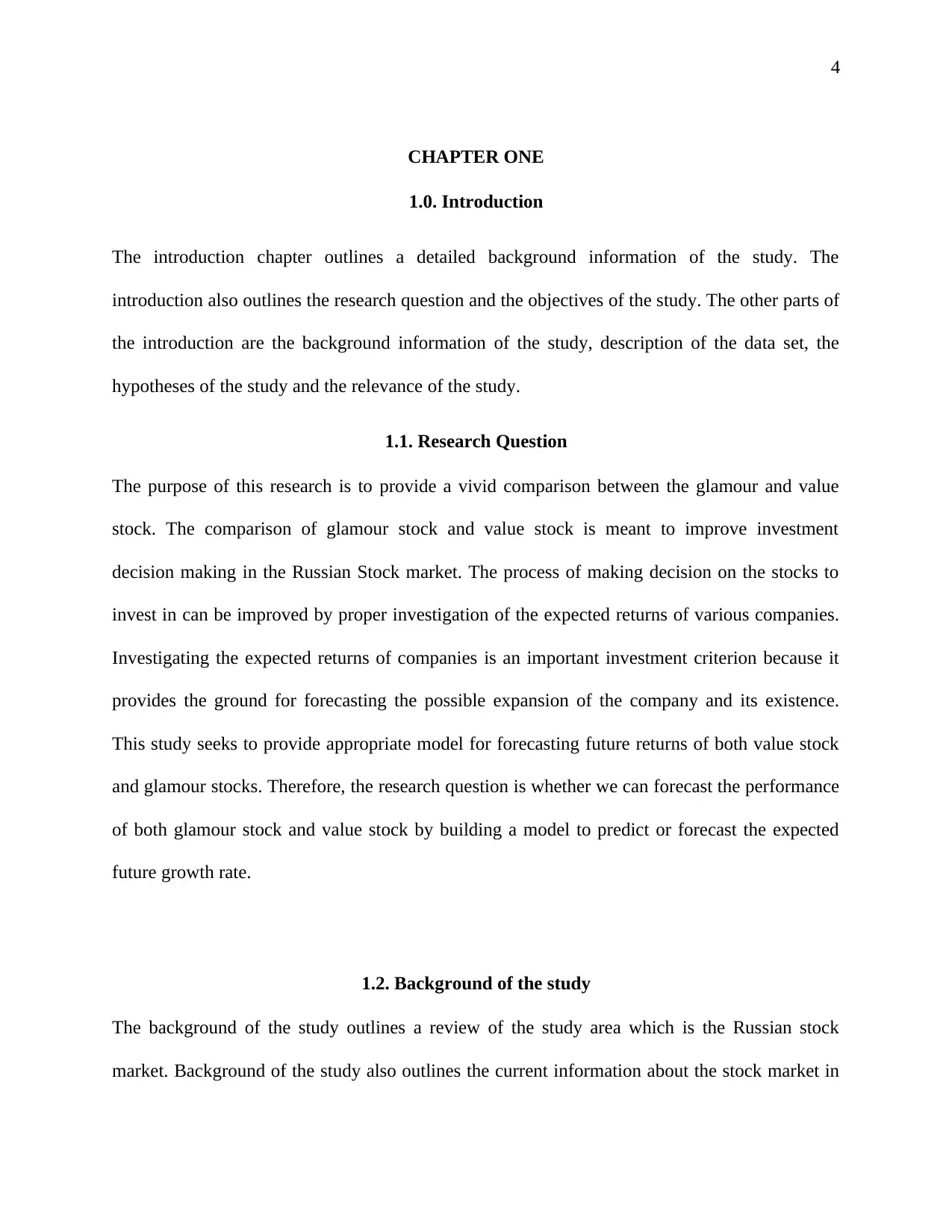
4
CHAPTER ONE
1.0. Introduction
The introduction chapter outlines a detailed background information of the study. The
introduction also outlines the research question and the objectives of the study. The other parts of
the introduction are the background information of the study, description of the data set, the
hypotheses of the study and the relevance of the study.
1.1. Research Question
The purpose of this research is to provide a vivid comparison between the glamour and value
stock. The comparison of glamour stock and value stock is meant to improve investment
decision making in the Russian Stock market. The process of making decision on the stocks to
invest in can be improved by proper investigation of the expected returns of various companies.
Investigating the expected returns of companies is an important investment criterion because it
provides the ground for forecasting the possible expansion of the company and its existence.
This study seeks to provide appropriate model for forecasting future returns of both value stock
and glamour stocks. Therefore, the research question is whether we can forecast the performance
of both glamour stock and value stock by building a model to predict or forecast the expected
future growth rate.
1.2. Background of the study
The background of the study outlines a review of the study area which is the Russian stock
market. Background of the study also outlines the current information about the stock market in
CHAPTER ONE
1.0. Introduction
The introduction chapter outlines a detailed background information of the study. The
introduction also outlines the research question and the objectives of the study. The other parts of
the introduction are the background information of the study, description of the data set, the
hypotheses of the study and the relevance of the study.
1.1. Research Question
The purpose of this research is to provide a vivid comparison between the glamour and value
stock. The comparison of glamour stock and value stock is meant to improve investment
decision making in the Russian Stock market. The process of making decision on the stocks to
invest in can be improved by proper investigation of the expected returns of various companies.
Investigating the expected returns of companies is an important investment criterion because it
provides the ground for forecasting the possible expansion of the company and its existence.
This study seeks to provide appropriate model for forecasting future returns of both value stock
and glamour stocks. Therefore, the research question is whether we can forecast the performance
of both glamour stock and value stock by building a model to predict or forecast the expected
future growth rate.
1.2. Background of the study
The background of the study outlines a review of the study area which is the Russian stock
market. Background of the study also outlines the current information about the stock market in
Paraphrase This Document
Need a fresh take? Get an instant paraphrase of this document with our AI Paraphraser
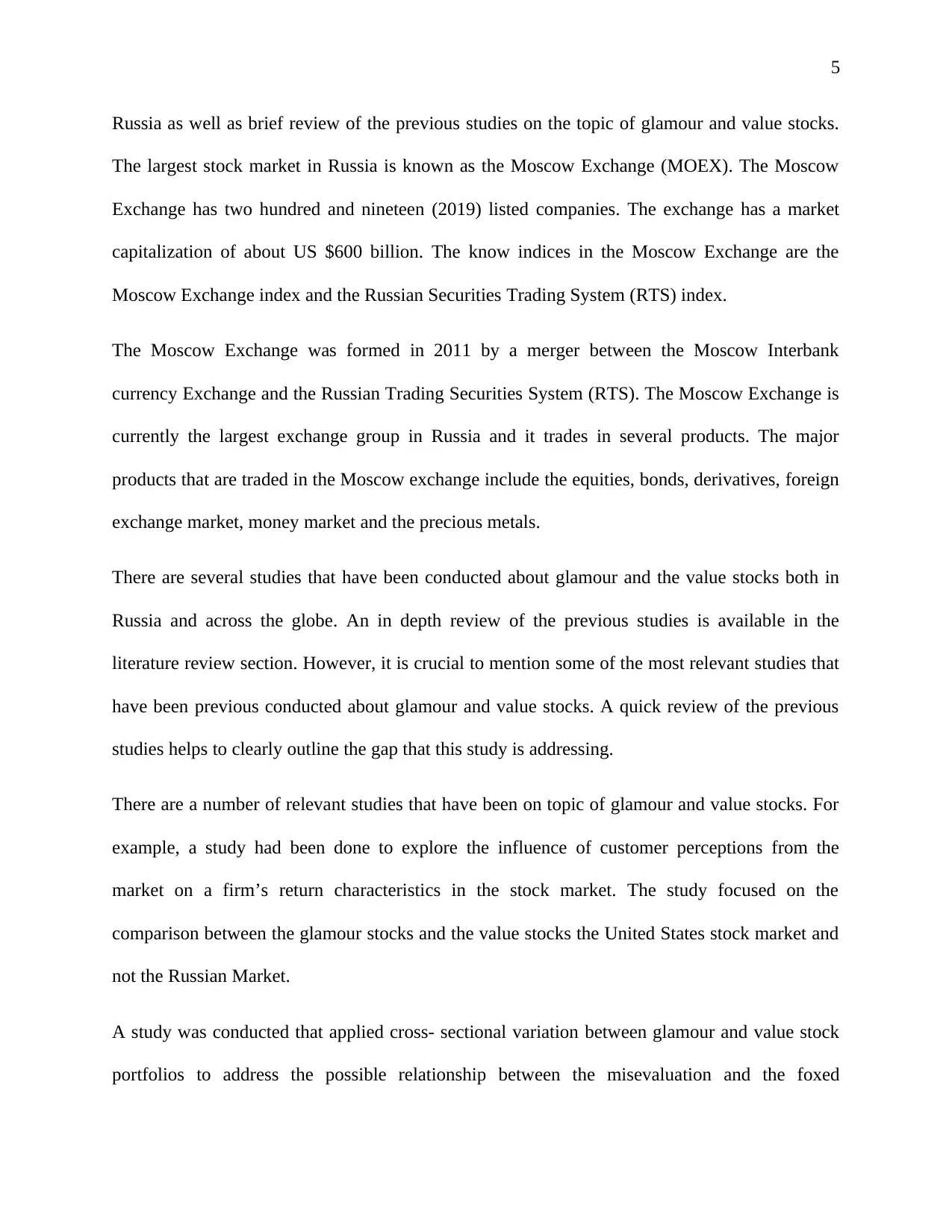
5
Russia as well as brief review of the previous studies on the topic of glamour and value stocks.
The largest stock market in Russia is known as the Moscow Exchange (MOEX). The Moscow
Exchange has two hundred and nineteen (2019) listed companies. The exchange has a market
capitalization of about US $600 billion. The know indices in the Moscow Exchange are the
Moscow Exchange index and the Russian Securities Trading System (RTS) index.
The Moscow Exchange was formed in 2011 by a merger between the Moscow Interbank
currency Exchange and the Russian Trading Securities System (RTS). The Moscow Exchange is
currently the largest exchange group in Russia and it trades in several products. The major
products that are traded in the Moscow exchange include the equities, bonds, derivatives, foreign
exchange market, money market and the precious metals.
There are several studies that have been conducted about glamour and the value stocks both in
Russia and across the globe. An in depth review of the previous studies is available in the
literature review section. However, it is crucial to mention some of the most relevant studies that
have been previous conducted about glamour and value stocks. A quick review of the previous
studies helps to clearly outline the gap that this study is addressing.
There are a number of relevant studies that have been on topic of glamour and value stocks. For
example, a study had been done to explore the influence of customer perceptions from the
market on a firm’s return characteristics in the stock market. The study focused on the
comparison between the glamour stocks and the value stocks the United States stock market and
not the Russian Market.
A study was conducted that applied cross- sectional variation between glamour and value stock
portfolios to address the possible relationship between the misevaluation and the foxed
Russia as well as brief review of the previous studies on the topic of glamour and value stocks.
The largest stock market in Russia is known as the Moscow Exchange (MOEX). The Moscow
Exchange has two hundred and nineteen (2019) listed companies. The exchange has a market
capitalization of about US $600 billion. The know indices in the Moscow Exchange are the
Moscow Exchange index and the Russian Securities Trading System (RTS) index.
The Moscow Exchange was formed in 2011 by a merger between the Moscow Interbank
currency Exchange and the Russian Trading Securities System (RTS). The Moscow Exchange is
currently the largest exchange group in Russia and it trades in several products. The major
products that are traded in the Moscow exchange include the equities, bonds, derivatives, foreign
exchange market, money market and the precious metals.
There are several studies that have been conducted about glamour and the value stocks both in
Russia and across the globe. An in depth review of the previous studies is available in the
literature review section. However, it is crucial to mention some of the most relevant studies that
have been previous conducted about glamour and value stocks. A quick review of the previous
studies helps to clearly outline the gap that this study is addressing.
There are a number of relevant studies that have been on topic of glamour and value stocks. For
example, a study had been done to explore the influence of customer perceptions from the
market on a firm’s return characteristics in the stock market. The study focused on the
comparison between the glamour stocks and the value stocks the United States stock market and
not the Russian Market.
A study was conducted that applied cross- sectional variation between glamour and value stock
portfolios to address the possible relationship between the misevaluation and the foxed
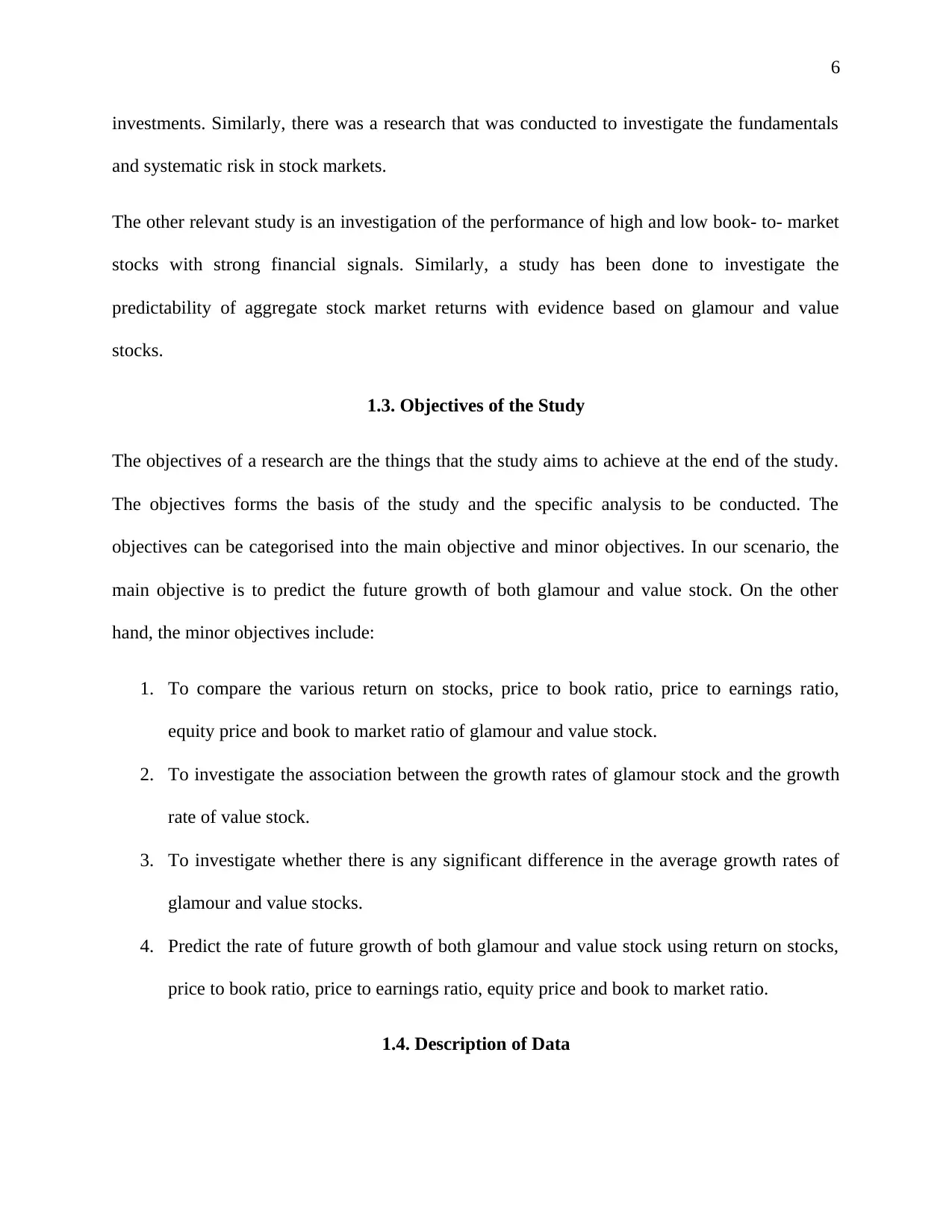
6
investments. Similarly, there was a research that was conducted to investigate the fundamentals
and systematic risk in stock markets.
The other relevant study is an investigation of the performance of high and low book- to- market
stocks with strong financial signals. Similarly, a study has been done to investigate the
predictability of aggregate stock market returns with evidence based on glamour and value
stocks.
1.3. Objectives of the Study
The objectives of a research are the things that the study aims to achieve at the end of the study.
The objectives forms the basis of the study and the specific analysis to be conducted. The
objectives can be categorised into the main objective and minor objectives. In our scenario, the
main objective is to predict the future growth of both glamour and value stock. On the other
hand, the minor objectives include:
1. To compare the various return on stocks, price to book ratio, price to earnings ratio,
equity price and book to market ratio of glamour and value stock.
2. To investigate the association between the growth rates of glamour stock and the growth
rate of value stock.
3. To investigate whether there is any significant difference in the average growth rates of
glamour and value stocks.
4. Predict the rate of future growth of both glamour and value stock using return on stocks,
price to book ratio, price to earnings ratio, equity price and book to market ratio.
1.4. Description of Data
investments. Similarly, there was a research that was conducted to investigate the fundamentals
and systematic risk in stock markets.
The other relevant study is an investigation of the performance of high and low book- to- market
stocks with strong financial signals. Similarly, a study has been done to investigate the
predictability of aggregate stock market returns with evidence based on glamour and value
stocks.
1.3. Objectives of the Study
The objectives of a research are the things that the study aims to achieve at the end of the study.
The objectives forms the basis of the study and the specific analysis to be conducted. The
objectives can be categorised into the main objective and minor objectives. In our scenario, the
main objective is to predict the future growth of both glamour and value stock. On the other
hand, the minor objectives include:
1. To compare the various return on stocks, price to book ratio, price to earnings ratio,
equity price and book to market ratio of glamour and value stock.
2. To investigate the association between the growth rates of glamour stock and the growth
rate of value stock.
3. To investigate whether there is any significant difference in the average growth rates of
glamour and value stocks.
4. Predict the rate of future growth of both glamour and value stock using return on stocks,
price to book ratio, price to earnings ratio, equity price and book to market ratio.
1.4. Description of Data
⊘ This is a preview!⊘
Do you want full access?
Subscribe today to unlock all pages.

Trusted by 1+ million students worldwide
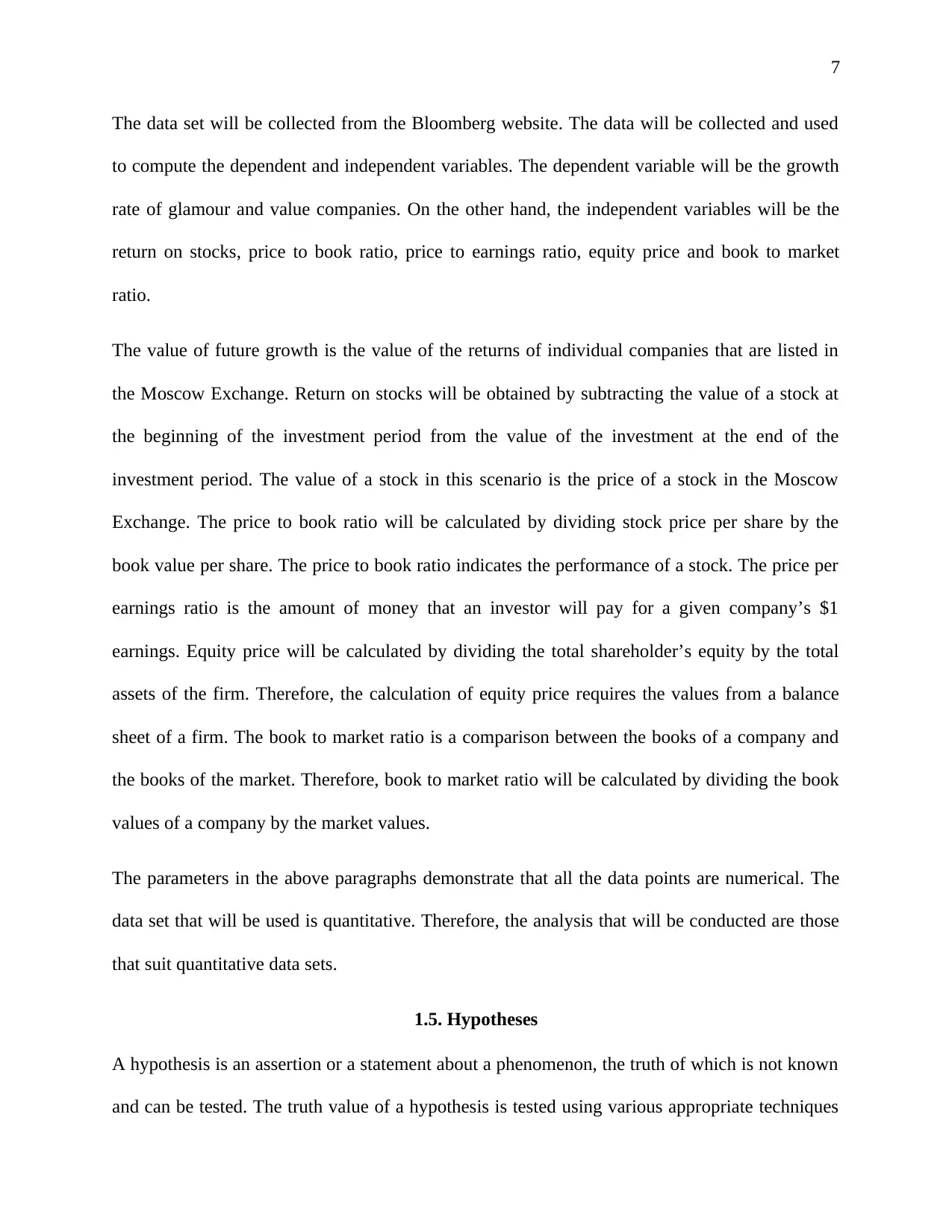
7
The data set will be collected from the Bloomberg website. The data will be collected and used
to compute the dependent and independent variables. The dependent variable will be the growth
rate of glamour and value companies. On the other hand, the independent variables will be the
return on stocks, price to book ratio, price to earnings ratio, equity price and book to market
ratio.
The value of future growth is the value of the returns of individual companies that are listed in
the Moscow Exchange. Return on stocks will be obtained by subtracting the value of a stock at
the beginning of the investment period from the value of the investment at the end of the
investment period. The value of a stock in this scenario is the price of a stock in the Moscow
Exchange. The price to book ratio will be calculated by dividing stock price per share by the
book value per share. The price to book ratio indicates the performance of a stock. The price per
earnings ratio is the amount of money that an investor will pay for a given company’s $1
earnings. Equity price will be calculated by dividing the total shareholder’s equity by the total
assets of the firm. Therefore, the calculation of equity price requires the values from a balance
sheet of a firm. The book to market ratio is a comparison between the books of a company and
the books of the market. Therefore, book to market ratio will be calculated by dividing the book
values of a company by the market values.
The parameters in the above paragraphs demonstrate that all the data points are numerical. The
data set that will be used is quantitative. Therefore, the analysis that will be conducted are those
that suit quantitative data sets.
1.5. Hypotheses
A hypothesis is an assertion or a statement about a phenomenon, the truth of which is not known
and can be tested. The truth value of a hypothesis is tested using various appropriate techniques
The data set will be collected from the Bloomberg website. The data will be collected and used
to compute the dependent and independent variables. The dependent variable will be the growth
rate of glamour and value companies. On the other hand, the independent variables will be the
return on stocks, price to book ratio, price to earnings ratio, equity price and book to market
ratio.
The value of future growth is the value of the returns of individual companies that are listed in
the Moscow Exchange. Return on stocks will be obtained by subtracting the value of a stock at
the beginning of the investment period from the value of the investment at the end of the
investment period. The value of a stock in this scenario is the price of a stock in the Moscow
Exchange. The price to book ratio will be calculated by dividing stock price per share by the
book value per share. The price to book ratio indicates the performance of a stock. The price per
earnings ratio is the amount of money that an investor will pay for a given company’s $1
earnings. Equity price will be calculated by dividing the total shareholder’s equity by the total
assets of the firm. Therefore, the calculation of equity price requires the values from a balance
sheet of a firm. The book to market ratio is a comparison between the books of a company and
the books of the market. Therefore, book to market ratio will be calculated by dividing the book
values of a company by the market values.
The parameters in the above paragraphs demonstrate that all the data points are numerical. The
data set that will be used is quantitative. Therefore, the analysis that will be conducted are those
that suit quantitative data sets.
1.5. Hypotheses
A hypothesis is an assertion or a statement about a phenomenon, the truth of which is not known
and can be tested. The truth value of a hypothesis is tested using various appropriate techniques
Paraphrase This Document
Need a fresh take? Get an instant paraphrase of this document with our AI Paraphraser
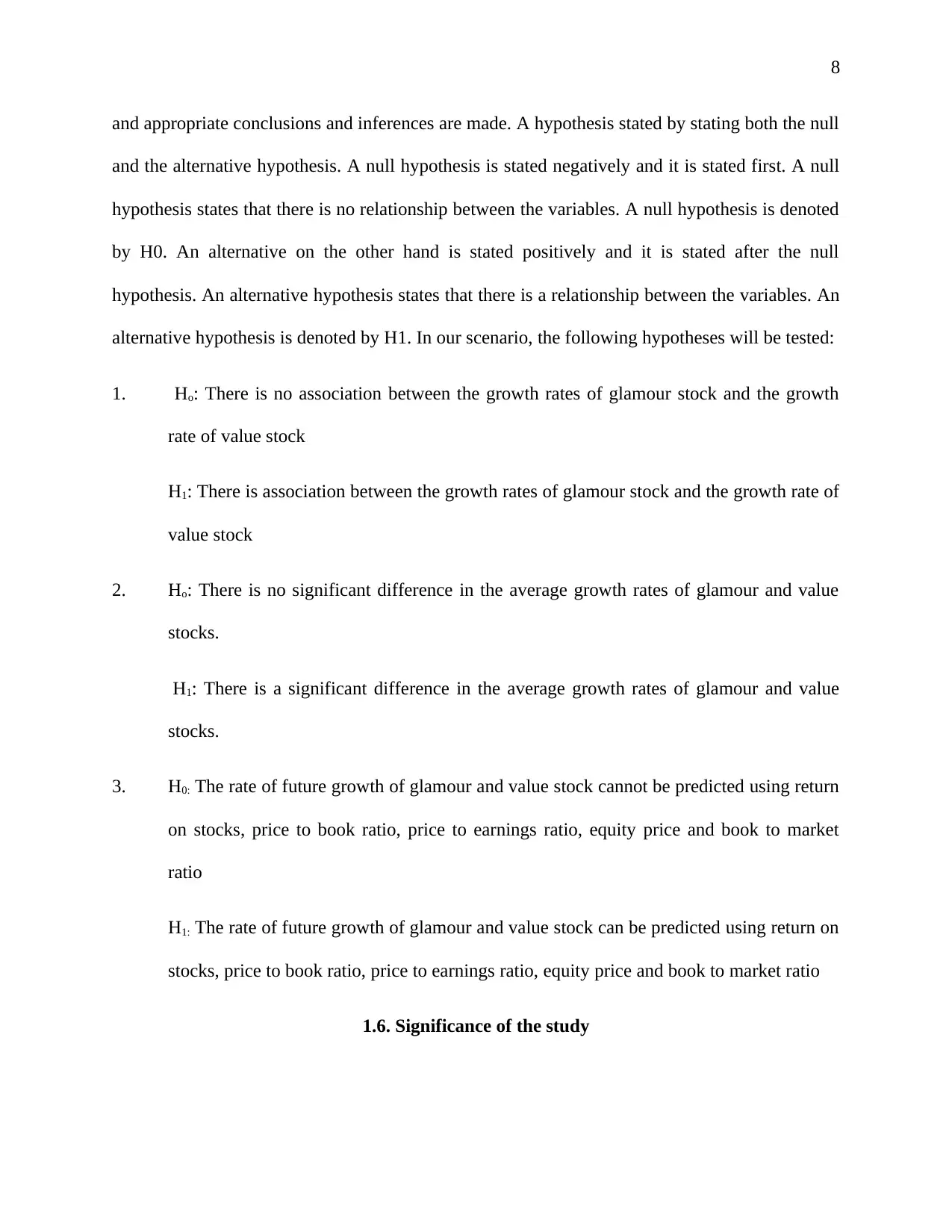
8
and appropriate conclusions and inferences are made. A hypothesis stated by stating both the null
and the alternative hypothesis. A null hypothesis is stated negatively and it is stated first. A null
hypothesis states that there is no relationship between the variables. A null hypothesis is denoted
by H0. An alternative on the other hand is stated positively and it is stated after the null
hypothesis. An alternative hypothesis states that there is a relationship between the variables. An
alternative hypothesis is denoted by H1. In our scenario, the following hypotheses will be tested:
1. Ho: There is no association between the growth rates of glamour stock and the growth
rate of value stock
H1: There is association between the growth rates of glamour stock and the growth rate of
value stock
2. Ho: There is no significant difference in the average growth rates of glamour and value
stocks.
H1: There is a significant difference in the average growth rates of glamour and value
stocks.
3. H0: The rate of future growth of glamour and value stock cannot be predicted using return
on stocks, price to book ratio, price to earnings ratio, equity price and book to market
ratio
H1: The rate of future growth of glamour and value stock can be predicted using return on
stocks, price to book ratio, price to earnings ratio, equity price and book to market ratio
1.6. Significance of the study
and appropriate conclusions and inferences are made. A hypothesis stated by stating both the null
and the alternative hypothesis. A null hypothesis is stated negatively and it is stated first. A null
hypothesis states that there is no relationship between the variables. A null hypothesis is denoted
by H0. An alternative on the other hand is stated positively and it is stated after the null
hypothesis. An alternative hypothesis states that there is a relationship between the variables. An
alternative hypothesis is denoted by H1. In our scenario, the following hypotheses will be tested:
1. Ho: There is no association between the growth rates of glamour stock and the growth
rate of value stock
H1: There is association between the growth rates of glamour stock and the growth rate of
value stock
2. Ho: There is no significant difference in the average growth rates of glamour and value
stocks.
H1: There is a significant difference in the average growth rates of glamour and value
stocks.
3. H0: The rate of future growth of glamour and value stock cannot be predicted using return
on stocks, price to book ratio, price to earnings ratio, equity price and book to market
ratio
H1: The rate of future growth of glamour and value stock can be predicted using return on
stocks, price to book ratio, price to earnings ratio, equity price and book to market ratio
1.6. Significance of the study
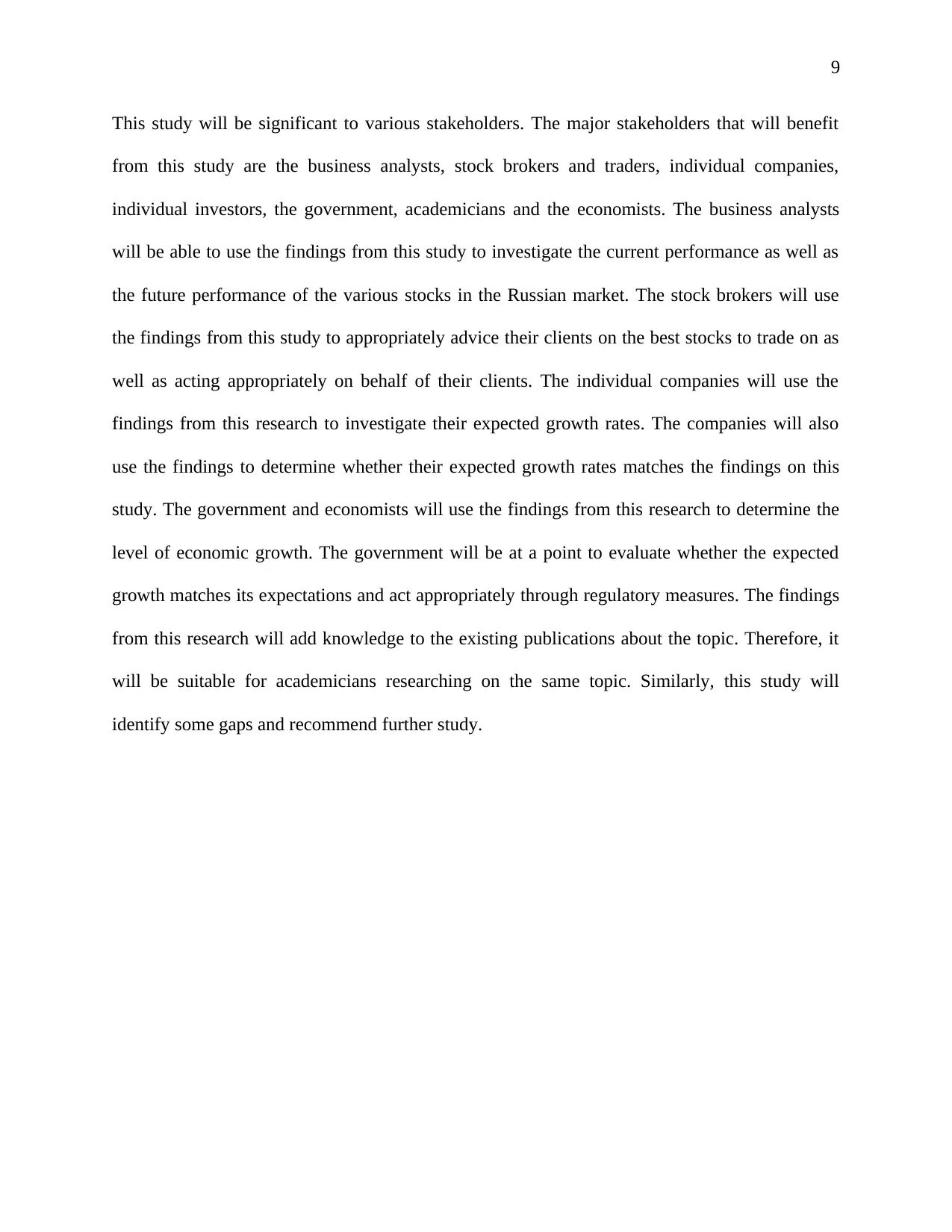
9
This study will be significant to various stakeholders. The major stakeholders that will benefit
from this study are the business analysts, stock brokers and traders, individual companies,
individual investors, the government, academicians and the economists. The business analysts
will be able to use the findings from this study to investigate the current performance as well as
the future performance of the various stocks in the Russian market. The stock brokers will use
the findings from this study to appropriately advice their clients on the best stocks to trade on as
well as acting appropriately on behalf of their clients. The individual companies will use the
findings from this research to investigate their expected growth rates. The companies will also
use the findings to determine whether their expected growth rates matches the findings on this
study. The government and economists will use the findings from this research to determine the
level of economic growth. The government will be at a point to evaluate whether the expected
growth matches its expectations and act appropriately through regulatory measures. The findings
from this research will add knowledge to the existing publications about the topic. Therefore, it
will be suitable for academicians researching on the same topic. Similarly, this study will
identify some gaps and recommend further study.
This study will be significant to various stakeholders. The major stakeholders that will benefit
from this study are the business analysts, stock brokers and traders, individual companies,
individual investors, the government, academicians and the economists. The business analysts
will be able to use the findings from this study to investigate the current performance as well as
the future performance of the various stocks in the Russian market. The stock brokers will use
the findings from this study to appropriately advice their clients on the best stocks to trade on as
well as acting appropriately on behalf of their clients. The individual companies will use the
findings from this research to investigate their expected growth rates. The companies will also
use the findings to determine whether their expected growth rates matches the findings on this
study. The government and economists will use the findings from this research to determine the
level of economic growth. The government will be at a point to evaluate whether the expected
growth matches its expectations and act appropriately through regulatory measures. The findings
from this research will add knowledge to the existing publications about the topic. Therefore, it
will be suitable for academicians researching on the same topic. Similarly, this study will
identify some gaps and recommend further study.
⊘ This is a preview!⊘
Do you want full access?
Subscribe today to unlock all pages.

Trusted by 1+ million students worldwide
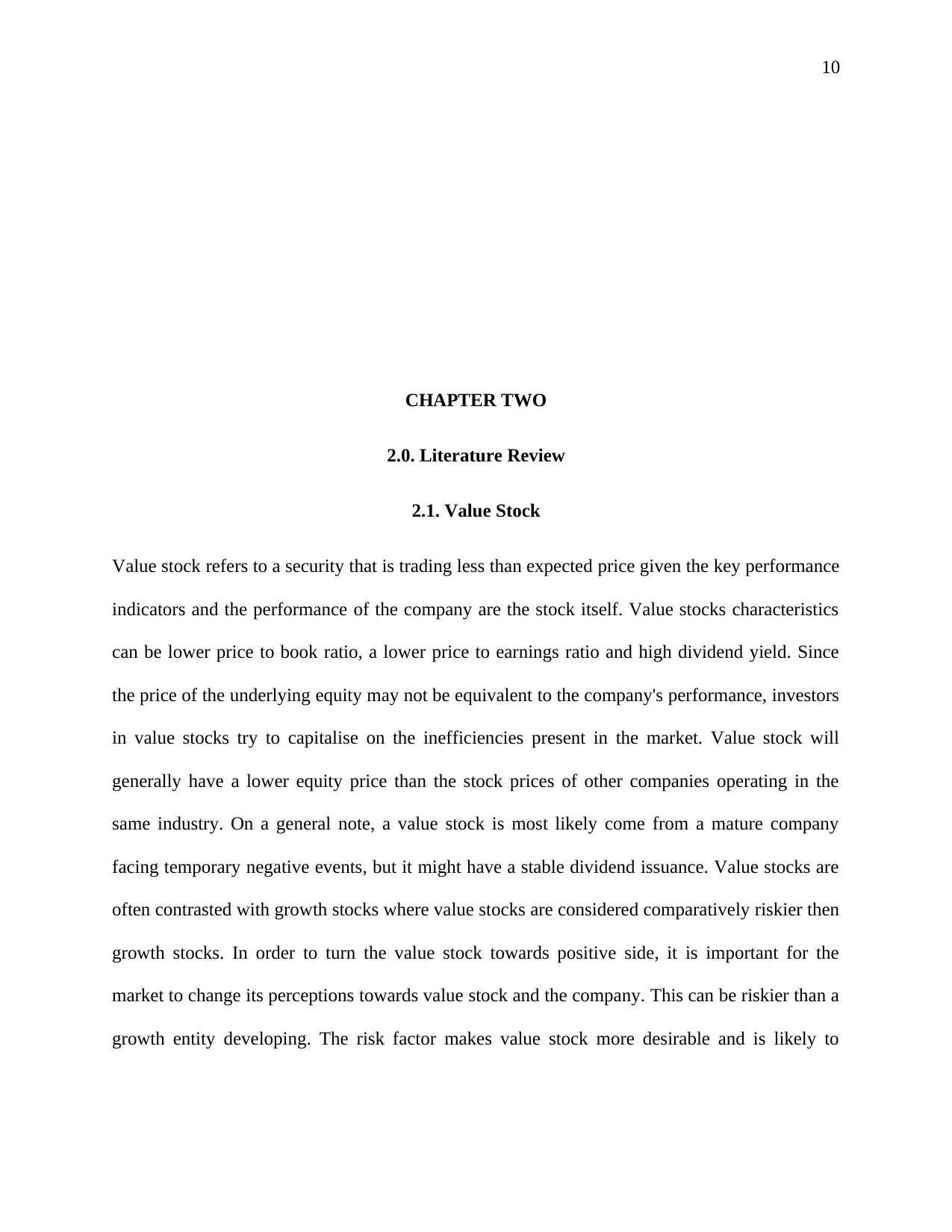
10
CHAPTER TWO
2.0. Literature Review
2.1. Value Stock
Value stock refers to a security that is trading less than expected price given the key performance
indicators and the performance of the company are the stock itself. Value stocks characteristics
can be lower price to book ratio, a lower price to earnings ratio and high dividend yield. Since
the price of the underlying equity may not be equivalent to the company's performance, investors
in value stocks try to capitalise on the inefficiencies present in the market. Value stock will
generally have a lower equity price than the stock prices of other companies operating in the
same industry. On a general note, a value stock is most likely come from a mature company
facing temporary negative events, but it might have a stable dividend issuance. Value stocks are
often contrasted with growth stocks where value stocks are considered comparatively riskier then
growth stocks. In order to turn the value stock towards positive side, it is important for the
market to change its perceptions towards value stock and the company. This can be riskier than a
growth entity developing. The risk factor makes value stock more desirable and is likely to
CHAPTER TWO
2.0. Literature Review
2.1. Value Stock
Value stock refers to a security that is trading less than expected price given the key performance
indicators and the performance of the company are the stock itself. Value stocks characteristics
can be lower price to book ratio, a lower price to earnings ratio and high dividend yield. Since
the price of the underlying equity may not be equivalent to the company's performance, investors
in value stocks try to capitalise on the inefficiencies present in the market. Value stock will
generally have a lower equity price than the stock prices of other companies operating in the
same industry. On a general note, a value stock is most likely come from a mature company
facing temporary negative events, but it might have a stable dividend issuance. Value stocks are
often contrasted with growth stocks where value stocks are considered comparatively riskier then
growth stocks. In order to turn the value stock towards positive side, it is important for the
market to change its perceptions towards value stock and the company. This can be riskier than a
growth entity developing. The risk factor makes value stock more desirable and is likely to
Paraphrase This Document
Need a fresh take? Get an instant paraphrase of this document with our AI Paraphraser
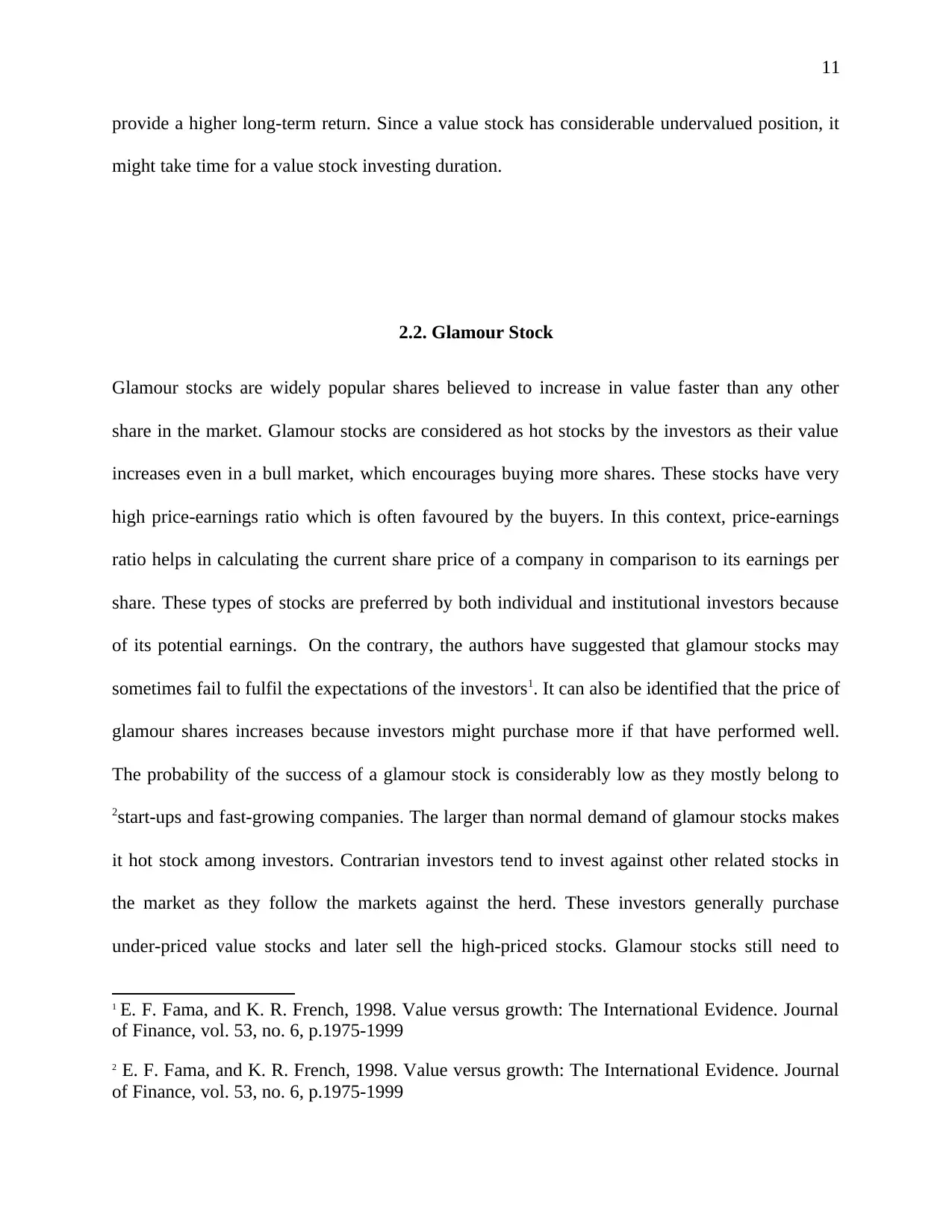
11
provide a higher long-term return. Since a value stock has considerable undervalued position, it
might take time for a value stock investing duration.
2.2. Glamour Stock
Glamour stocks are widely popular shares believed to increase in value faster than any other
share in the market. Glamour stocks are considered as hot stocks by the investors as their value
increases even in a bull market, which encourages buying more shares. These stocks have very
high price-earnings ratio which is often favoured by the buyers. In this context, price-earnings
ratio helps in calculating the current share price of a company in comparison to its earnings per
share. These types of stocks are preferred by both individual and institutional investors because
of its potential earnings. On the contrary, the authors have suggested that glamour stocks may
sometimes fail to fulfil the expectations of the investors1. It can also be identified that the price of
glamour shares increases because investors might purchase more if that have performed well.
The probability of the success of a glamour stock is considerably low as they mostly belong to
2start-ups and fast-growing companies. The larger than normal demand of glamour stocks makes
it hot stock among investors. Contrarian investors tend to invest against other related stocks in
the market as they follow the markets against the herd. These investors generally purchase
under-priced value stocks and later sell the high-priced stocks. Glamour stocks still need to
1 E. F. Fama, and K. R. French, 1998. Value versus growth: The International Evidence. Journal
of Finance, vol. 53, no. 6, p.1975-1999
2 E. F. Fama, and K. R. French, 1998. Value versus growth: The International Evidence. Journal
of Finance, vol. 53, no. 6, p.1975-1999
provide a higher long-term return. Since a value stock has considerable undervalued position, it
might take time for a value stock investing duration.
2.2. Glamour Stock
Glamour stocks are widely popular shares believed to increase in value faster than any other
share in the market. Glamour stocks are considered as hot stocks by the investors as their value
increases even in a bull market, which encourages buying more shares. These stocks have very
high price-earnings ratio which is often favoured by the buyers. In this context, price-earnings
ratio helps in calculating the current share price of a company in comparison to its earnings per
share. These types of stocks are preferred by both individual and institutional investors because
of its potential earnings. On the contrary, the authors have suggested that glamour stocks may
sometimes fail to fulfil the expectations of the investors1. It can also be identified that the price of
glamour shares increases because investors might purchase more if that have performed well.
The probability of the success of a glamour stock is considerably low as they mostly belong to
2start-ups and fast-growing companies. The larger than normal demand of glamour stocks makes
it hot stock among investors. Contrarian investors tend to invest against other related stocks in
the market as they follow the markets against the herd. These investors generally purchase
under-priced value stocks and later sell the high-priced stocks. Glamour stocks still need to
1 E. F. Fama, and K. R. French, 1998. Value versus growth: The International Evidence. Journal
of Finance, vol. 53, no. 6, p.1975-1999
2 E. F. Fama, and K. R. French, 1998. Value versus growth: The International Evidence. Journal
of Finance, vol. 53, no. 6, p.1975-1999
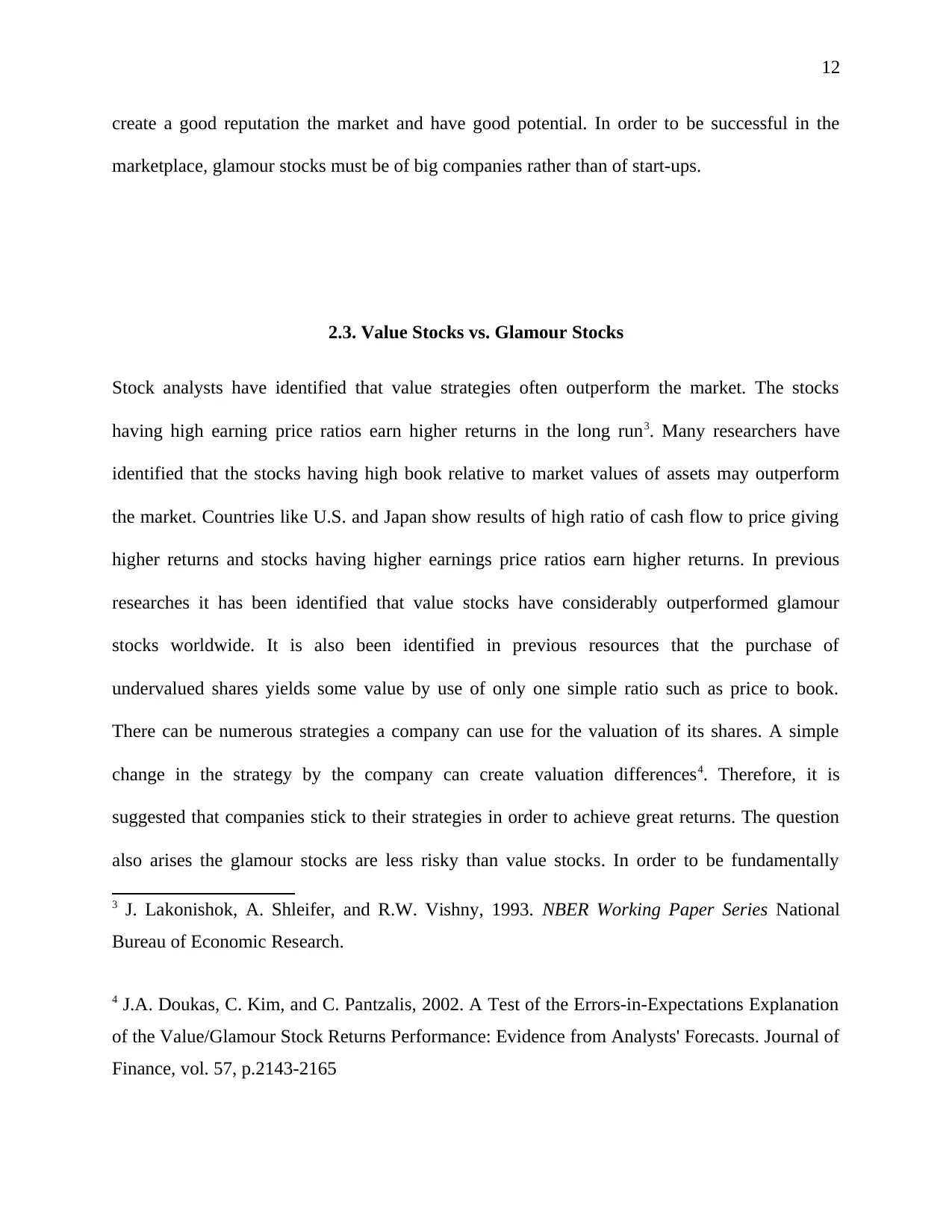
12
create a good reputation the market and have good potential. In order to be successful in the
marketplace, glamour stocks must be of big companies rather than of start-ups.
2.3. Value Stocks vs. Glamour Stocks
Stock analysts have identified that value strategies often outperform the market. The stocks
having high earning price ratios earn higher returns in the long run3. Many researchers have
identified that the stocks having high book relative to market values of assets may outperform
the market. Countries like U.S. and Japan show results of high ratio of cash flow to price giving
higher returns and stocks having higher earnings price ratios earn higher returns. In previous
researches it has been identified that value stocks have considerably outperformed glamour
stocks worldwide. It is also been identified in previous resources that the purchase of
undervalued shares yields some value by use of only one simple ratio such as price to book.
There can be numerous strategies a company can use for the valuation of its shares. A simple
change in the strategy by the company can create valuation differences4. Therefore, it is
suggested that companies stick to their strategies in order to achieve great returns. The question
also arises the glamour stocks are less risky than value stocks. In order to be fundamentally
3 J. Lakonishok, A. Shleifer, and R.W. Vishny, 1993. NBER Working Paper Series National
Bureau of Economic Research.
4 J.A. Doukas, C. Kim, and C. Pantzalis, 2002. A Test of the Errors-in-Expectations Explanation
of the Value/Glamour Stock Returns Performance: Evidence from Analysts' Forecasts. Journal of
Finance, vol. 57, p.2143-2165
create a good reputation the market and have good potential. In order to be successful in the
marketplace, glamour stocks must be of big companies rather than of start-ups.
2.3. Value Stocks vs. Glamour Stocks
Stock analysts have identified that value strategies often outperform the market. The stocks
having high earning price ratios earn higher returns in the long run3. Many researchers have
identified that the stocks having high book relative to market values of assets may outperform
the market. Countries like U.S. and Japan show results of high ratio of cash flow to price giving
higher returns and stocks having higher earnings price ratios earn higher returns. In previous
researches it has been identified that value stocks have considerably outperformed glamour
stocks worldwide. It is also been identified in previous resources that the purchase of
undervalued shares yields some value by use of only one simple ratio such as price to book.
There can be numerous strategies a company can use for the valuation of its shares. A simple
change in the strategy by the company can create valuation differences4. Therefore, it is
suggested that companies stick to their strategies in order to achieve great returns. The question
also arises the glamour stocks are less risky than value stocks. In order to be fundamentally
3 J. Lakonishok, A. Shleifer, and R.W. Vishny, 1993. NBER Working Paper Series National
Bureau of Economic Research.
4 J.A. Doukas, C. Kim, and C. Pantzalis, 2002. A Test of the Errors-in-Expectations Explanation
of the Value/Glamour Stock Returns Performance: Evidence from Analysts' Forecasts. Journal of
Finance, vol. 57, p.2143-2165
⊘ This is a preview!⊘
Do you want full access?
Subscribe today to unlock all pages.

Trusted by 1+ million students worldwide
1 out of 32
Related Documents
Your All-in-One AI-Powered Toolkit for Academic Success.
+13062052269
info@desklib.com
Available 24*7 on WhatsApp / Email
![[object Object]](/_next/static/media/star-bottom.7253800d.svg)
Unlock your academic potential
Copyright © 2020–2025 A2Z Services. All Rights Reserved. Developed and managed by ZUCOL.





